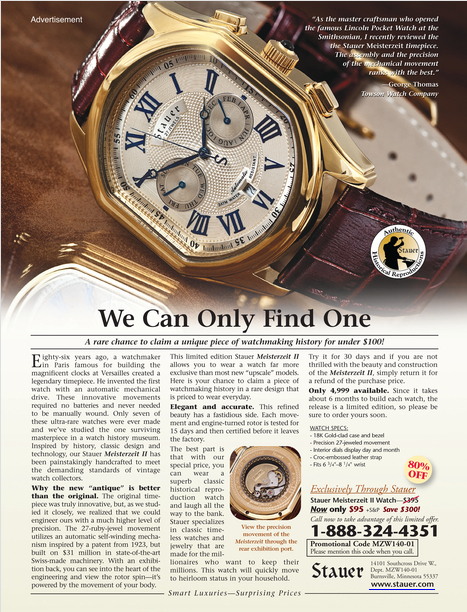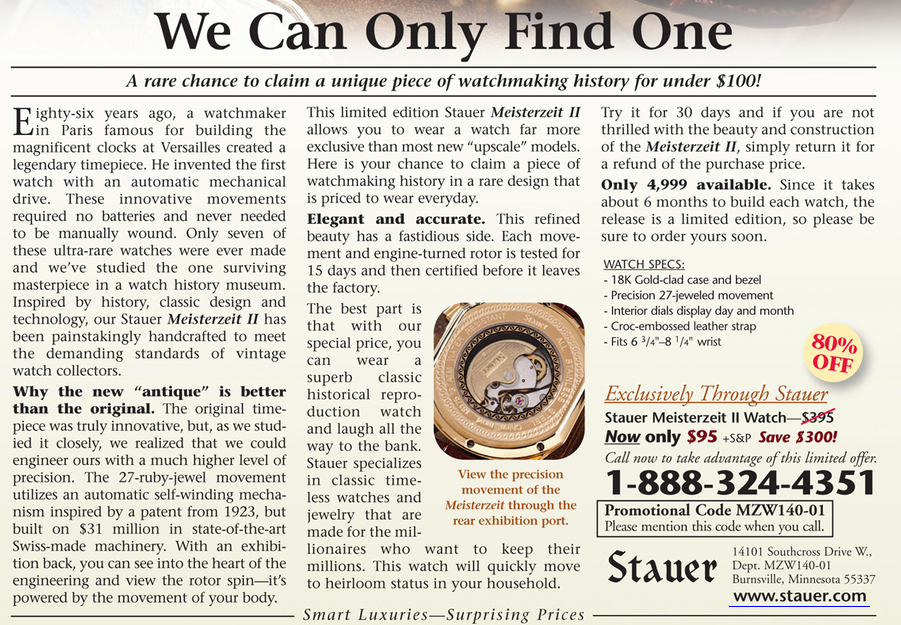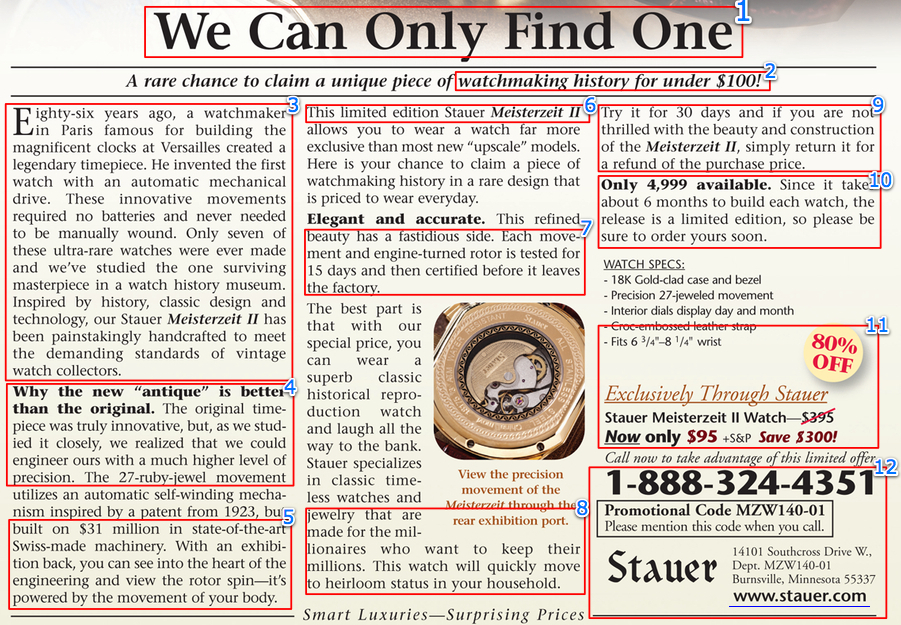Blog
Direct Response Ad Case Study (Stauer Watch)
This direct response ad case study is from a Stauer watch advertisement I found on a plane ride in 2020.
Direct response copywriting is a dying art form. Most modern DTC eCommerce sites don’t use it. They prefer the efficiency of describing their products in bullet points. They forget that in order to romanticize the buyer (and the buyer is looking to be seduced) you need to construct a story.
This Stauer ad indulges in some very sexy copywriting (bigger text version in the next paragraph):

The first thing I noticed was the testimonial (social proof is so important for cold traffic). Here is the zoomed image:

One could not hope for a better endorsement. It comes from a gentleman who is himself a master craftsman. I have never heard of Mr. George Thomas but am certainly aware of the Smithsonian. Excellent, you’ve got my attention Stauer.
We will now dissect this direct response ad case study line by line but let me first zoom out and show you the ad as I saw it in 2010. Below this image, you’ll find another image with a bunch of annotations. Below that second annotated image we’ll explain all the clever direct-response copywriting tricks this marketer is using.
But first, stroll around the ad and form your own opinion:

I have a confession, I’m a recovering infomercial addict (hi Lars). I’ve never bought anything but have been known to spend hours gazing at people with British accents sell things I didn’t realize I needed. But I didn’t watch infomercials because I suffered from insomnia I watched them because I thought they were brilliant marketing tactics. Alright, now let’s break up this direct response ad case study into sections.
In the image below you will notice numbers. Those numbers correspond to the written numbered notes below the image. I originally wrote this article in 2010. I’m updating it in 2023. Our annotation process is so much better now. I’m sorry, but this old post uses the old system where you will need to see a number, scroll down to see the explanation, then scroll up to see the next number. But the content is good. I promise.

1: This headline is a classic marketing play on scarcity. Got my attention. Check.
2: Incredible value is the hook that lives in the nucleus of all good infomercials. When the brain encounters a product it attempts to put a value on it. This ad is about a rare beautiful watch so I expect a price tag between $200 and $2,000. With that mental anchor, $100 is a steal.
3: I like how they directly jump into the story. The reader goes from 0 to 100. I really like this starting style. Immediately the writer is connecting us with someone who did something very rare a long time ago. The term “studied” positions these guys are experts (Demonstrate Expertise).
4: This is a classic “but-wait-there’s-more” line. The prospect is already thinking the watch is a steal and now the advertiser is upping the ante. This watch is better than the priceless original. Beat that.
5: Again, clever use of anchoring. The company has invested $31 million to produce a $100 watch. If the brain had constructed the “if the watch is $100 it must be crap” argument it would now feel secure knowing a significant investment has been made toward production.
6: Another play on scarcity.
7: Not only are we selling at the ridiculously low price of $100 we test the watch motor for 15 days. Note: the use of the number 15 is deliberate. Every time the brain is confronted with a claim it can do one of three things: believe it, think it’s an exaggeration, or think it’s a lie. But 15 is such a precise number. It must be true.
8: By suggesting Stauer watches are made for millionaires they are asking if we want to join that exclusive group. Who wouldn’t?
9: Risk reversal. At this point, people in the market for such a watch are ready to pull the trigger but the 30-day money-back guarantee is another ridiculous giveaway.
10: 4,999 is a classic play on scarcity. If I was working on this ad I would have removed this scarcity line. Scarcity is so overused I think buyers assume it’s fake.
I hope you are liking this direct response ad case study so far.
Yes
— or —
No
11: We are used to discounts that represent fractions of the price. So we’d expect a $10 discount on a $100 item. A $300 saving on a $100 item is an uncomputable deal; my brain is almost fried. Are you telling me with my savings I could buy three more Stauer Meisterzeit II Timepieces??
12: There is nothing much to talk about here except the promotional code. MZW140-01 was chosen for a very specific reason. Think about it, they could have used a promo code like SALE1 but their idea is to give a code the customer has to note down. It also creates a sense that this is a special offer.
In the end, Stauer wants to communicate one of two emotions:
Emotion 1: Our marketing department has made a typo. The moment our CEO finds out about this ridiculous offer they’ll lose their jobs and you’ll lose the deal. So hurry up and make the purchase.
Emotion 2: Something horrible has happened at our company, maybe we are about to shut down. We don’t want to cause mass hysteria so we are quickly liquidating our inventory. This is why we’re willing to take a loss on this magnificent watch. So hurry up and make the purchase.
Bottom line, do I believe this ad worked? Yes, yes, and yes. I bet Stauer has sold over 50,000 of these 4,999 watches!!
But Wait There’s More
First of all, fewer than 0.0004% of all marketers would ever find this article. So right off the bat, I know you and I are cut from the same cloth. If you want to see more of my favorite direct response ads head here: The History of Conversion Rate Optimization.
But there is something else I want to share. Here’s the deal. We’ve been running marketing experiments for our eCommerce clients for the last 16 years.
Our clients have invested over $3,900,000 with us to understand shopper behavior on their sites.
And what we’ve discovered is this— to massively improve conversion rates you need to do something that seems illogical. You need to ignore 84% of all visitors to your site and triple down on a very specific group. We call this group, Healthy Skeptics.






Comments 13
Excellent post! Every point made sense to me.
Replybetterretail
Yay! Thanks Seema, you’re the best 🙂
ReplyFirst infomercials, and now deconstructing full page direct response ads! I love it.
Replybetterretail
The two loves of my life, what can I say 🙂
ReplyThanks for the insight, something I always do when I look at these ads in SMITHSONIAN. Yet, when I question it outload, I hear I am too negative…I am with you on this, 100%.
ReplyWow, I would feel foolish for buying one but it is a beautiful watch.
ReplyI have the Meisterzeit a Graves 33 and the Reulator 7.
ReplyThey get more comments than my Rolex Presidential that everyone asked if it’s fake. All of my Stauer’s keep perfect time and cost less than having the Rolex serviced just once. The Graves 33 is almost 4 years old and the only thing that I have worn out is the band. Stauer sells new bands for $25.00
Their watches won’t cost you a arm an a leg, they keep good time and they look great. What more could you want for a C-Note.
betterretail
ENSapp, I’m happy you’ve enjoyed your Stauer watch. This post discusses their marketing strategy. I am not talking about their actual watch, which I don’t own.
ReplyFGrimes
You can buy a Seiko watch for half the price and twice the quality, not to mention better styling. Don’t be suckered by this sleazy marketing.
ReplyJust an aside… the product that Stauer is selling is way better than what you would get from China. Yes, it is slick marketing. No, I did not buy the (watches) that I have because they were junk. I bought one under the 30 day return ontract and was please with the value for the dollar. Then, I purchased mnore of the watches I liked. I will keep them and use them and know that they represent a time gone by…
ReplyThe ad (in National Geographic)has been improved (thanks to your post?): the 4999 watches are gone, the inaccurate 80% off has been replaced by the more accurate 76% (300/395) but the 18k gold has been downgraded to 14 k.
ReplyVery interesting
All the watches with discounted price tag are “Made in China” but the ones NOT discounted are “NOT Made in China” !! This gives the answer for 4999 !!
ReplyI bought a Stauer Meisterzeit Automatic about one year ago in 2010. It is a very nice looking watch
Replyalthough a bit thicker than most watches I have owned. After one or two months use the screw from
the rotor fell off inside the case. I replaced the screw myself (whether this became a problem or, not I do not know). The watch worked flawlessly for about six months of intermittent use. I change watches frequently. Now, within the last three weeks, it stops running. I wound it for a short time per automatic watch directions, set it down and let it run out three or four times. Then I wound it to start and wore it. It stops within 5-6 hours every time. Even the best of watches can have a bad one in the lot, but in this case I really think that the Meisterzeit is not worth the money. It is a very smart looking watch overall. When it runs it seems to keep time fairly accurately. When it runs. I ordered a new automatic from a reputable company with equal gook looks at a reasonable price in my estimation. I think its time for a change. Later I will compare the two here.